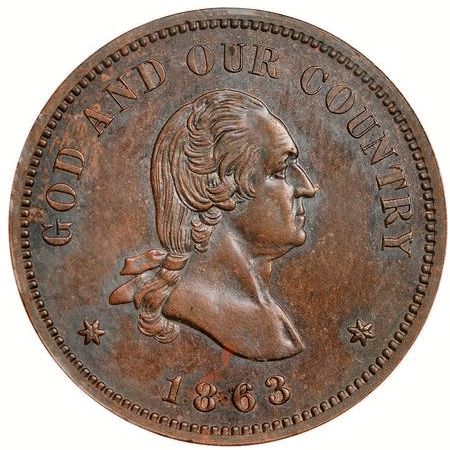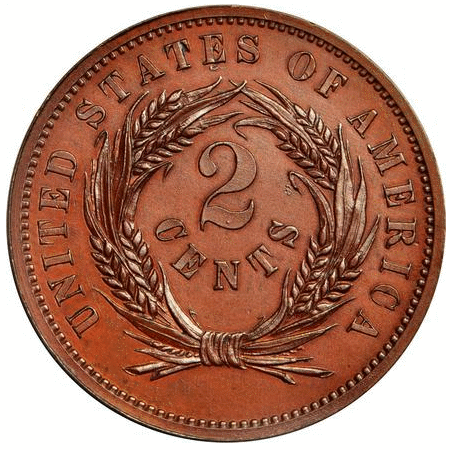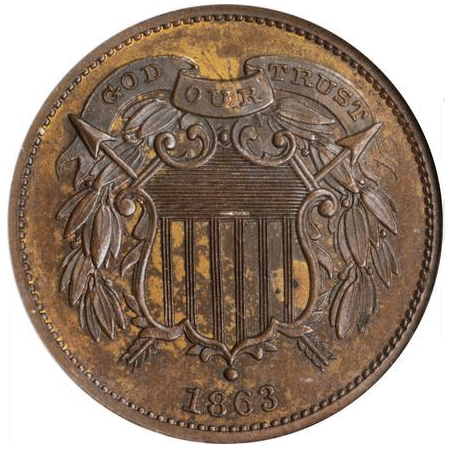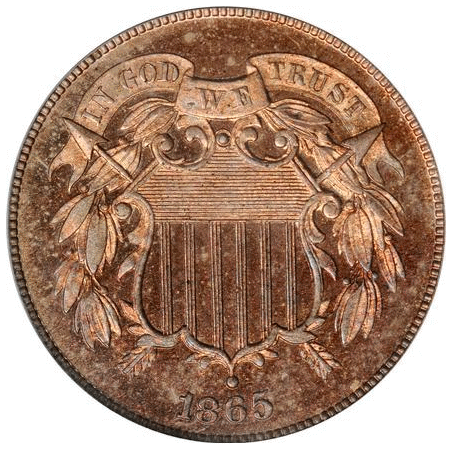Analysis regarding scarce coins, markets, and coin collecting #345
A Weekly CoinWeek Column by Greg Reynolds …..
It has already been explained, in Part 15 of a series about classic U.S. coins, that a set of regular issue, business strike Two Cent Pieces may be completed without spending as much as $500 on any one coin. Patterns are more expensive, though may be more interesting to collectors who are already familiar with regular issue Two Cent Pieces.
Of course, to non-collectors and beginning collectors, the notion of a Two Cent Piece tends to be very interesting. As is true of Three Cent Nickels, members of the general public are often entertained or startled when they learn that Two Cent Pieces existed and circulated widely in the U.S.
Regular Two Cent Pieces were struck from 1864 to 1873. These were specified to be 95% copper, with the balance being tin and/or zinc, an alloy often thought of as ‘bronze’.
In Good-04 grade, representatives of more than a half-dozen dates, in the regular series, could be purchased for less than $25 each. Patterns from this era tend to grade from 45 to 65, and are typically classified as Proofs.
There was debate about the meaning, nature and form of the new Two Cent copper (‘bronze’) denomination. Patterns of different designs and/or alloys were struck so that influential people could attain an understanding of the artistic, metallurgical and dimensional possibilities.
As stated in Part One of this series on patterns for less than $5,000 each, though not coins, patterns are similar to coins, directly related to coins and often collected along with coins. More than a few coin patterns circulated in commerce. Indeed, some Two Cent Piece patterns circulated, probably after 1864.
“Generally speaking, for less than $5000 each, a collector should be able to build a nice type set of four or five Two Cent Piece patterns, including an 1836 in either billon or copper,” remarks Saul Teichman, a sophisticated collector for decades. Saul is the leading researcher of pedigrees of patterns and has extensively researched pedigrees of some very rare, regular issue U.S. coins as well.
The notion of a Two Cent Piece was seriously contemplated circa 1836 when Small Eagle type Two Cent Piece patterns were made. There were restrikes for collectors during the late 1850s. People who are just beginning to collect patterns should not become too concerned about the distinction between originals and restrikes with the original dies. It is often difficult to theorize as to the exact years that such items were made. Originals, restrikes and novodels (with backdated dies) are all enthusiastically collected in the present.
Small Eagle Patterns
 Most Small Eagle patterns are billon, which refers to alloys that contain both silver and copper (or bronze) but are mostly copper. Usually, to be defined as billon, an alloy must consist of at least 51% copper and at least 5% silver. Some other metals may be present in a billon alloy, though not nickel.
Most Small Eagle patterns are billon, which refers to alloys that contain both silver and copper (or bronze) but are mostly copper. Usually, to be defined as billon, an alloy must consist of at least 51% copper and at least 5% silver. Some other metals may be present in a billon alloy, though not nickel.
There are “1836” Small Eagle Two Cent patterns with wear or minor issues that would be likely to sell for less than $5,000, when offered. A patient collector could surely obtain one.
In August 2013, Heritage sold a billon “1836“ that is NGC-graded as “AU-58.” It brought $5,287.50. On June 3, 2013, the Goldbergs auctioned an NGC-graded “45“ 1836 Two Cent Piece pattern in copper, with a sticker of approval from CAC, for $2,300.
At the September 2010 Long Beach Expo, an 1836, which is likely to be billon, was auctioned for $862.50. It is in a ‘PCGS Genuine’ holder. Images suggest that it may have the details of an AU grade, and may possibly have suffered from a substantial chemical cleaning. It still is sharp and appealing.
Earlier, in May 2009, an NGC-certified “Proof-64” copper piece brought $4,887.50. This same piece would probably sell for more if auctioned this autumn.
George Washington Patterns
Two Cent Piece patterns featuring a bust of George Washington are extremely important in the context of the history of the U.S. Mint. A U.S. president was not featured on a regular issue U.S. coin until the Lincoln cent was introduced in 1909.
 The first U.S. president to be depicted on a U.S. coin of any sort was Thomas Jefferson, who appeared on the obverse of a Louisiana Purchase commemorative One Dollar Gold coin in 1903. William McKinley appears on a different Louisiana Purchase 1903 One Dollar Gold commemorative, which has the same reverse design as the Jefferson piece.
The first U.S. president to be depicted on a U.S. coin of any sort was Thomas Jefferson, who appeared on the obverse of a Louisiana Purchase commemorative One Dollar Gold coin in 1903. William McKinley appears on a different Louisiana Purchase 1903 One Dollar Gold commemorative, which has the same reverse design as the Jefferson piece.
The Washington quarter was first minted in 1932, though it was not then clear that it would be a regularly occurring issue. No quarters were minted in 1933, though Washington quarters have been minted from 1934 to the present. Washington quarters struck in 1975 and in 1976 bear the dual date, “1776-1976” to commemorate the bicentennial of the declaration of independence.
There are multiple varieties of Washington Two Cent Piece patterns of 1863. There are slight differences in design and different alloys were employed, reportedly including copper (J-305), copper-nickel (J-306), oroide (J-307) and aluminum (J-308). Saul Teichman has questioned whether oroide pieces of this type ever really existed. For a basic type set, one Washington Two Cent Piece pattern of any alloy is enough.
Judd numbers are a means for identifying varieties of patterns as listed in the Judd reference, which was first published in 1959. The 10th edition was released by Whitman Publishing of Atlanta, Georgia, in 2008.
In June 2010, Stack’s-Bowers auctioned a Washington Two Cent Piece pattern in copper, which was PCGS-certified as ‘Proof-63 Red & Brown,’ from “Sherman’s Obsessive Compulsive Collection”. This pattern sold for $1,840.
 In September 2013, Stack’s-Bowers auctioned another Washington of this same Judd-305 variety, which was PCGS-certified as ‘Proof-62 Brown.’ The price realized was $1,880.
In September 2013, Stack’s-Bowers auctioned another Washington of this same Judd-305 variety, which was PCGS-certified as ‘Proof-62 Brown.’ The price realized was $1,880.
A different, PCGS-certified ‘Pr-62 BN’ of this variety was auctioned in Tampa during January 2011. That pattern brought $2,247.10. A PCGS-certified ‘Proof-64 BN’ representative of this Washington Two Cent Piece pattern in copper sold for $4,600 by Stack’s-Bowers in Baltimore during June 2011.
At the other end of the price range is a non-gradable J-305 piece in an NGC ‘details’ holder, which the Goldbergs auctioned on January 26, 2015, for $940. Its level of detail is high in the AU range.
The J-310 variety is very similar to the J-305 variety. The J-305 to J-308 varieties all feature an unusual and very distinctive arrangement of letters in the word ‘cents’ on the reverse.
The J-309 to J-311 varieties are characterized by a reverse of the same design as regular issue Two Cent Pieces, though are of different alloys. In January 2015, Heritage sold an NGC-certified ‘Proof-62 BN’ J-310 copper piece for $2,820.
The copper-nickel and aluminum Washington Two Cent Piece patterns tend to be much more expensive than copper (or ‘bronze’) patterns of this type. Nevertheless, it is fortunate for budget-minded collectors that Washington Two Cent Pieces in copper tend to be available for less than $3,000, sometimes for less than $1,000. The mere consideration of a presidential portrait, rather than a female personification of liberty or other philosophical symbols, was a break in tradition and foreshadowed a later change in policy.
“God Our Trust”!
In 1863, there were shield type Two Cent Piece patterns that featured an alternative motto, “God Our Trust,” rather than the adopted motto, “In God We Trust“. In 1864, Two Cent Pieces became the first U.S. coins to include such a motto.
 In 1866, the adopted motto, “In God We Trust,” was prominent in the design of newly-introduced Shield five cent nickels, and was added to the reverse designs of quarters, half dollars, silver dollars, half eagles ($5 gold coins), eagles ($10) and double eagles ($20 coins).
In 1866, the adopted motto, “In God We Trust,” was prominent in the design of newly-introduced Shield five cent nickels, and was added to the reverse designs of quarters, half dollars, silver dollars, half eagles ($5 gold coins), eagles ($10) and double eagles ($20 coins).
On the J-312 variety, “God Our Trust” appears on the obverse and the letters of the word ‘cents’ are distinctively laid out in the reverse design. These are the unusual “curved letters” that characterize an already mentioned subtype of Washington Two Cent Piece patterns.
At the ANA Convention in August 2013, Stack’s-Bowers auctioned one of these “God Our Trust” obverse, unusual “cents” reverse, shield Two Cent Piece patterns (J-312). It was NGC-certified as ‘Proof-66 Red & Brown,’ and realized $4,465.
The J-312 is one of the least rare patterns, though is still rare. In January 2013, Stack’s-Bowers sold an NGC-certified ‘65 BN’ piece for $2,531.18. On Monday, January 27, 2014, the Goldbergs auctioned a PCGS-certified ‘Proof-65 BN’ piece, with a CAC sticker, for $,3878.
In August 2014, Stack’s-Bowers auctioned an NGC-certified ‘Proof-64 Brown’ representative of this same variety for $1,645. A few months earlier, in March, another J-312 pattern, with the same NGC certification, sold for $1,880.
Maybe Not A Year Early?
Is the most understandable category of patterns those that appear the same as regular issues, yet are dated a year or two before the corresponding regular issues were first issued? Liberty Head nickel patterns of 1882 come to mind.
As Two Cent Pieces became coins in 1864, 1863 dated items of the same obverse and reverse designs as 1864 regular issues are interesting patterns that collectors of regular issues often add to sets. Unfortunately, it is not clear as to when these were made.
It has been theorized that 1863 Two Cent Piece patterns of the design adopted in 1864 were actually produced for collectors during the 1870s. In any event, it is unlikely that a decent one of these could be obtained for less than $5,000 in the near future.
Trials Or Experiments with Regular Dies
During the 19th century, there are many instances of pairs of regular dies being used for ‘patterns,’ broadly defined. In some cases, dies are tested on pure or nearly pure copper planchets (prepared blanks). In other cases, mint officials wished to learn of the nature of alternative metal strikings, in terms of mechanics and/or aesthetics.
 It is practical to seek a regular dies, 1864 ‘Large Motto’ Two Cent Piece pattern of the variety (J-371) with nickel content. From 1859 to some point in 1864, Indian cents were specified to be 12% nickel and 88% copper. Flying Eagle cents were earlier of this same 12% nickel composition. Are the “copper-nickel” Two Cent Piece patterns all of this same alloy?
It is practical to seek a regular dies, 1864 ‘Large Motto’ Two Cent Piece pattern of the variety (J-371) with nickel content. From 1859 to some point in 1864, Indian cents were specified to be 12% nickel and 88% copper. Flying Eagle cents were earlier of this same 12% nickel composition. Are the “copper-nickel” Two Cent Piece patterns all of this same alloy?
According to PCGS CoinFacts, on many occasions during the last 15 years, “copper-nickel” 1864 ‘Large Motto’ Two Cent patterns that are PCGS- or NGC-graded in the 63 to 65 range have each been auctioned for prices between $1,000 and $4,000.
There are multiple die pairings of 1865 Two Cent Piece patterns in a copper-nickel alloy. At the Spring Long Beach Expo in 2012, a PCGS certified ‘Proof-64’ piece was auctioned for $3,451.15. Another with the same certification was auctioned in Baltimore during March 2011 for $3,450. According to a cataloguer at Stack’s-Bowers, that piece was identified by experts at PCGS as being of the 12% nickel, 88% copper composition that characterized earlier Indian cents and Flying Eagle cents.
The J-409A Two Cent Piece patterns clearly consist of a higher percentage of nickel… are these of the 25% nickel, 75% copper alloy that was always standard for Three Cent Nickels and five cent nickels?
In Part One of this series, I drew attention to One Cent Nickels, which I find intriguing. The J-409A pieces are pattern Two Cent Nickels. Unfortunately, it is unlikely that a Two Cent Nickel could be obtained for less than $5,000. The analogous, off-metal 1866 and 1867 Two Cent Piece patterns are even rarer than their counterparts of 1865.
The regular dies, 1868 Two Cent Pieces in aluminum command attention. In January 2011, Heritage auctioned the “John H. Twist Collection” piece. It was NGC-certified as ‘Proof-63,’ and it was reported on the NGC label that this piece consists of 94% aluminum, 4% iron and 2% silicon. If so, this is a surprising alloy. Iron was never specified for use in regular issue U.S. coinage and tends to decompose in the short run, as does aluminum. This ‘94%’ aluminum 1868 Two Cent Piece went for $4,025.
Almost all U.S. coin patterns are rare. There are many cool pieces that can be purchased for less than $5,000 each.
© 2016 Greg Reynolds






From the standpoint of practicality as well as numismatics, it’s a shame the denomination never succeeded. A two-cent coin fits exactly into the 1/2/5 pattern of ratios needed by a true decimal coinage system, as evidenced by the number of countries that have issued it and/or its 20¢ counterpart*. Its existence today, perhaps in a more-convenient size, would have gone a long way towards reducing the Mint’s workload by replacing half or more of the ocean of pennies now being produced. Sigh.
* … ignoring here the fact that the quarter was never replaced, allowing our coinage to remain compatible with Spanish milled dollars unto the present day :)